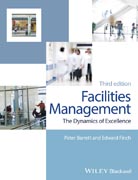
Facilities management continues to expand and develop in terms of the volume and diversity of commercial activity, with a significant influence upon organisational success and goal achievement. The two previous editions of Facilities Management have become established as key sources for all facilities management courses and forward thinking facilities managers, providing a strong blend of research–informed opportunities and practical, balanced advice for strategically orientated practitioners. This third edition builds on those foundations, focussing on the driving idea that excellent facilities management demands a responsive and dynamic approach to the positive impacts facilities can have on users operating within a world in flux. Within this overarching theme the book considers numerous contemporary issues facing facilities managers, within a framework that covers organisation, technology and process. INDICE: Preface ix Acknowledgements xiii I Dynamic, Strategic Facilities Management 1 1 Diversity and Balance in Facilities Management 3 1.1 Introduction 3 1.2 Generic FM model 4 1.3 Illustrations of facilities management systems 7 1.4 Facilities management models 14 1.5 Case studies 18 1.6 Conclusions 52 References 52 2 Excellence Through a Client/User Orientation 53 2.1 Introduction 53 2.2 Societal context 54 2.3 Built environment impacts on users 55 2.4 The complex sensory impacts of spaces 56 2.5 Focusing through user–orientated design principles 60 2.6 Conclusions 74 Endnote 76 References 76 3 Engaging with Stakeholder Needs 81 3.1 Introduction 81 3.2 The relationship between the facilities management function and user needs evaluation 83 3.3 Post–occupancy evaluation (POE) 88 3.4 Data collection: methods, analysis and presentation 98 3.5 Conclusions 105 References 105 Appendix: Post–occupancy evaluation data sheets 106 II Organising for FM 109 4 Organising for FM 111 4.1 Introduction 111 4.2 Performance measurement 112 4.3 Organising the FM team 113 4.4 Facilities management and measurement 114 4.5 Relationship approaches to FM 120 4.6 Flexibility and the FM organisation 127 4.7 Tangible and intangible FM 128 4.8 FM in the experience economy 134 4.9 Conclusions 136 References 137 5 Managing People Through Change 139 5.1 Introduction 139 5.2 Change as a threat or opportunity? 140 5.3 New service implementation cycle 140 5.4 Multi–faceted ‘space’ 145 5.5 Relinquishing the ‘old’ 156 5.6 Embracing the ‘new’ 157 5.7 Conclusions 161 References 161 6 Managing Briefing in Major Projects 165 6.1 Introduction 165 6.2 The importance of briefing 166 6.3 Five keys to successful briefing 167 6.4 Management of the briefing process 188 6.5 Information required during the briefing process 195 6.6 Conclusions 198 References 199 III FM Tools 201 7 Information Technology Tools for FM 203 7.1 Introduction 203 7.2 Information philosophy 204 7.3 Modern applications of IT in facilities management 204 7.4 Interoperability and collaboration 206 7.5 Knowledge management 211 7.6 IT governance models 214 7.7 Viable system model (VSM) 216 7.8 Conclusions 222 References 223 8 Decision Making 225 8.1 Introduction 225 8.2 Stage 1: Exploration of the nature of the problem 229 8.3 Stage 2: Generation of possible solutions 242 8.4 Stage 3: Choosing among possible solutions 249 8.5 Conclusions 270 References 275 IV Conclusions 277 9 Sustaining the Pursuit of FM Excellence 279 9.1 Introduction 279 9.2 Client perception of facilities management services 280 9.3 Stimulating and sustaining improvements 283 9.4 Strategic facilities management 290 9.5 Learning organisations 299 9.6 Conclusions and interactions 305 References 309 Appendix: Models of learning organisation 310 Index
- ISBN: 978-0-470-67397-3
- Editorial: Wiley–Blackwell
- Encuadernacion: Rústica
- Páginas: 336
- Fecha Publicación: 08/11/2013
- Nº Volúmenes: 1
- Idioma: Inglés
